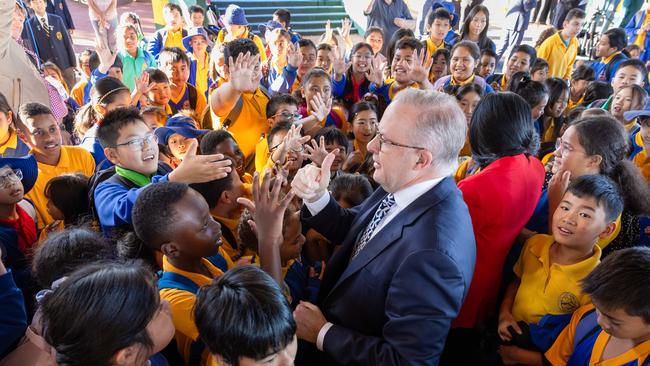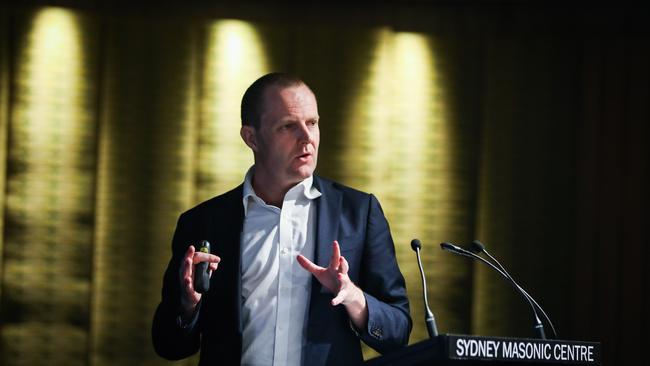‘Big Australia’ is over yet home hangover remains
Population growth has eased but we still need a surge in housing supply.

If Peter Dutton becomes prime minister he promises to introduce what he believes are four critical pieces of legislation on the first sitting day of the 48th parliament. One bill will be to reduce energy prices, another will be about keeping Australians safe; a third will be to guarantee funding for health, education and essential services. The fourth proposed measure is headlined The Lower Immigration and More Homes for Australians Bill.
“This is my signal to the Australian people of what my priorities will be in government,” the Opposition Leader said of his legislative quartet wish list in last week’s budget-in-reply speech.
The second goal of that last bill is at least on message for the key issue in housing: supply. But the first part of the title is redundant.
Forgive me for reviving an ancient tool of voter vibe but the worm has turned on Big Australia. The post-pandemic people surge is fading. Whoever wins on May 3 will inherit a normal migration inflow, but the pandemic’s long tail of havoc on home building will take years to settle down.
Unsurprisingly, housing affordability is near the top of voter concerns. According to Hugh Hartigan, even with a big outflow of foreigners during the pandemic, a sharp decline in average household size due to working from home led to an estimated 120,000 additional households.
“This unexpected shift helped offset the demand shock, which is why rents did not fall in a sustained way during this period,” the former head of research at Housing Australia tells Inquirer.
“Public concern about the impact of population growth on housing affordability is likely to be amplified during periods of constrained housing supply.”
He recalls the obverse case in the 2010s, when Sydney’s housing supply was strong relative to demand; rents grew in line with or more slowly than incomes.
The Coalition is trying to convince the electorate the post-pandemic population boom was caused by Labor; uncontrolled and unsustainable migration, it argues, is the reason roads and services are stressed, homes are so expensive, young people are shut out of the market and more people are homeless.

“Labor is neither in control of migration, nor has it kept migration at sustainable levels,” Dutton said. “And Australians know it. I don’t want young Australians locked out of the property market or having to rely on the bank of mum and dad.”
To reduce demand, Dutton promises to cut permanent migration by one-quarter (to 140,000 places), cap foreign student numbers and ban foreigners from buying an existing home. Slashing the skills-based permanent intake is a bad idea. This year 71 per cent of the 185,000 places in the program are for the skilled stream, with the rest reserved for family reunion (predominantly partners).
As the Department of Home Affairs notes in its annual stocktake, “around 60 per cent of visas under the Migration Program are granted to migrants already onshore and in the community, residing in established households at the time of visa grant”. For anyone who still thinks there’s a queue of people at our distant embassies applying to bring a family here, that notion was junked decades ago.
Many who should know better mix and mash up population growth, the permanent program, temporary visas and net overseas migration or NOM. Dutton, for instance, claims Labor has brought in a million people through the migration program. As a former home affairs minister he knows the distinctions. During the three-year post-Covid catch-up, the migration program has granted 570,000 permanent visas, or an annual average of 190,000 places. In the Coalition’s six years of pre-Covid rule, the average was 179,000.
The NOM – which is the number of people added to (or subtracted from) the population due to migration – has been much higher. Official numbers come with a lag because of the 12/16 rule; a traveller must have spent 12 of the past 16 months in or out of Australia to be counted as an arrival or departure.
Treasury’s budget estimates show NOM for the past three years to be: 536,000, 435,000 and 335,000 (forecast for 2024-25). That’s 1.3 million more foreigners, mainly students, workers and backpackers. Add in an estimated 310,000 due to natural increase (births less deaths) and the population has grown by 6.3 per cent.
That 2.1 per cent average annual clip is akin to the final nine years of the post-war Menzies era baby boom (1956 to 1964) and Kevin Rudd’s 2008 and 2009 dalliance with “Big Australia”.
Even so, we are 241,000 people short of the pre-crisis population trajectory the Coalition expected in Josh Frydenberg’s mid-year budget update in 2019. While the natural increase fell short by 427,000 (due to a plunge in the birthrate), we got 186,000 more migrants than anticipated.
But the dynamic has changed, with population growth peaking 18 months ago. A crackdown on visa hopping and dodgy educational operators, ministerial directions to slow foreign student arrivals and the end of pandemic era work rights have changed the game – and that’s the right term for how the visa system is abused by many applicants.

Labor’s attempt to cap foreign student numbers failed to win support in parliament; the Coalition claims it will impose a tougher cap on universities and colleges. Needless to say, there were a record 707,390 foreigners here on student visas at the end of February, as well as an all-time high number of working holiday makers (227,000) and temporary skilled workers (200,000).
Without student caps, Labor has gone to the Coalition’s migration playbook and pulled on the handbrake of visa processing. In the six months to December 2024 visa application processing times have blown out (compared with the same period in 2023): partner (first stage) from seven months to 10 months; students from 17 days to 40 days; temporary resident (skilled) from 16 days to 48 days.
The latest Australian Bureau of Statistics figures show a drop in migrant arrivals of almost 20 per cent over the year to last September; departures rose by the same proportion; NOM is now at an annual 380,000 and is expected to ease to 260,000 by mid-2026 (although Treasury’s recent forecasts have missed the mark).
Yet the drop in numbers has prompted experts from the Australian National University’s migration hub to call out what they expect will be the weaponisation of migration during the election campaign. Peter McDonald and Alan Gamlen note visa extensions to three years for British and Irish backpackers and pandemic-era measures have led to the emergence of a very large number of temporary migrants holding visas of the longer three to four years duration.
It has led to a bulge in delayed departures, some due to processing snarls and appeals. At the end of February there were 330,000 people on bridging visas, including many whose last resort had expired; 93,000 individuals not granted a final protection visa have yet to be deported.

“The departure numbers will be small in the next couple of years but they will increase sharply in three to four years’ time,” McDonald and Gamlen write in a policy brief published this week. “If the next government is still controlling arrivals by then, net overseas migration could fall sharply.”
The bigger risk, they argue, is “undue panic could induce kneejerk migration cuts that cause migration levels to whipsaw up and down, instead of settling back into a more stable normal”.
From next financial year, the migration program’s planning horizon will be extended from 12 months to four years. Home Affairs argues it will enable migration to better align with long-run infrastructure, housing and services planning across all levels of government. The multi-year approach will have housing supply as a key factor in shaping the direction of migration policy.
Dutton is on stronger ground in his policy to boost supply by 500,000 homes. He plans to put $5bn on the table for water, power, sewerage and roads to get housing projects up and running. Less helpful is the Coalition’s promise to also allow first-home buyers to access up to $50,000 of their super for a home deposit, a spur to demand for sure.
Plus Dutton will direct the Australian Prudential Regulation Authority to lower the current 3 per cent serviceability buffer, set when the cash rate was near zero, requiring lenders to assess a home loan applicant’s ability to repay a loan.
We’re not building enough homes, period. As the Productivity Commission has documented, the housing industry’s productivity is woeful. Regulatory changes and new building codes have been introduced without cost-benefit analysis; they can add tens of thousands of dollars to the cost of a home.
The massive post-Covid rises in building material costs and labour may have eased but price levels won’t be retreating. The gap between home building approvals and completions is becoming larger. Many companies have failed. Projects that got the green light, especially apartment developments, have stalled or are no longer feasible.
Dutton’s charge is that Labor hasn’t delivered a single extra new home under its “failed housing policies”.
Hartigan, however, sees rays of hope, as well as action in the provinces. While the National Housing Accord’s target of 1.2 million new homes by mid-2029 already appears to be behind the pace, it has been transformative.

To its credit, Hartigan argues, Canberra has reasserted itself in housing policy after the Coalition largely deferred to the states during its nine years in office. “At the very least, the accord has forced accountability across all levels of government, sharpening the focus on supply-side solutions,” he says. Hartigan says every policy tool must now be used, every level of government engaged and every effort made to turn the crisis around. “Policy should focus squarely on reducing construction costs and recalibrate market settings so that the private sector can deliver enough homes to meet new demand,” he says.
“Without that, affordability will continue to worsen. Over-supply should really be the goal, with the aim of achieving a sustained period where nominal dwelling prices rise less than household incomes.”
Labor has been obsessed with bringing down NOM, to the exclusion of bedding down the reforms it announced in December 2023 that would revitalise the visa system and deliver better outcomes for the nation and the migrants who settle, work, study and travel to our country.
There’s a lot more work to be done to speed up visa processing for skilled workers in hot demand globally, reform regional migration and the use of working holiday-makers, and revamp the “points system” for permanent migrants. But even more toil and hurry is required, no matter who prevails in the poll, to deliver the homes we need and can afford.






